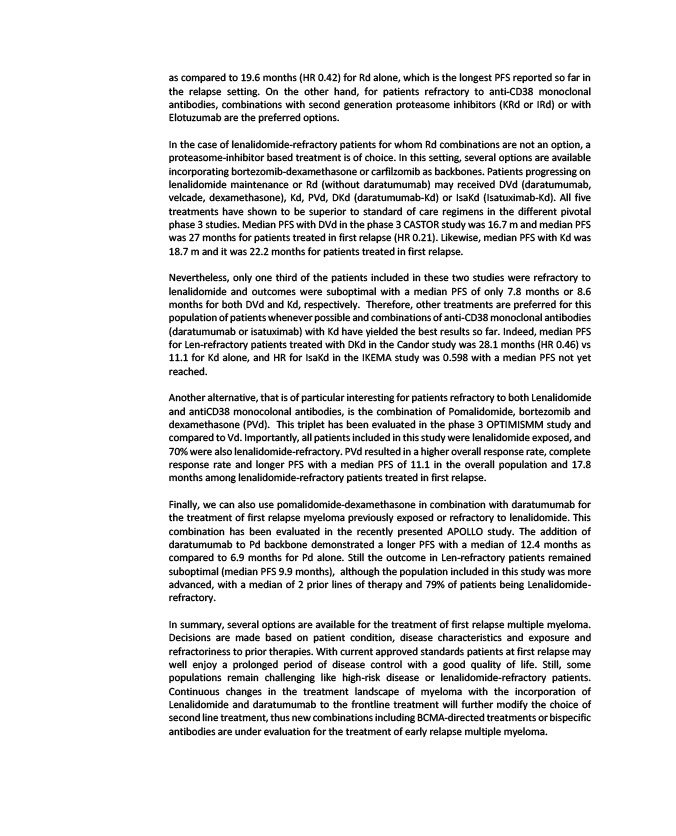
as compared to 19.6 months (HR 0.42) for Rd alone, which is the longest PFS reported so far in
the relapse setting. On the other hand, for patients refractory to anti-CD38 monoclonal
antibodies, combinations with second generation proteasome inhibitors (KRd or IRd) or with
Elotuzumab are the preferred options.
In the case of lenalidomide-refractory patients for whom Rd combinations are not an option, a
proteasome-inhibitor based treatment is of choice. In this setting, several options are available
incorporating bortezomib-dexamethasone or carfilzomib as backbones. Patients progressing on
lenalidomide maintenance or Rd (without daratumumab) may received DVd (daratumumab,
velcade, dexamethasone), Kd, PVd, DKd (daratumumab-Kd) or IsaKd (Isatuximab-Kd). All five
treatments have shown to be superior to standard of care regimens in the different pivotal
phase 3 studies. Median PFS with DVd in the phase 3 CASTOR study was 16.7 m and median PFS
was 27 months for patients treated in first relapse (HR 0.21). Likewise, median PFS with Kd was
18.7 m and it was 22.2 months for patients treated in first relapse.
Nevertheless, only one third of the patients included in these two studies were refractory to
lenalidomide and outcomes were suboptimal with a median PFS of only 7.8 months or 8.6
months for both DVd and Kd, respectively. Therefore, other treatments are preferred for this
population of patients whenever possible and combinations of anti-CD38 monoclonal antibodies
(daratumumab or isatuximab) with Kd have yielded the best results so far. Indeed, median PFS
for Len-refractory patients treated with DKd in the Candor study was 28.1 months (HR 0.46) vs
11.1 for Kd alone, and HR for IsaKd in the IKEMA study was 0.598 with a median PFS not yet
reached.
Another alternative, that is of particular interesting for patients refractory to both Lenalidomide
and antiCD38 monocolonal antibodies, is the combination of Pomalidomide, bortezomib and
dexamethasone (PVd). This triplet has been evaluated in the phase 3 OPTIMISMM study and
compared to Vd. Importantly, all patients included in this study were lenalidomide exposed, and
70% were also lenalidomide-refractory. PVd resulted in a higher overall response rate, complete
response rate and longer PFS with a median PFS of 11.1 in the overall population and 17.8
months among lenalidomide-refractory patients treated in first relapse.
Finally, we can also use pomalidomide-dexamethasone in combination with daratumumab for
the treatment of first relapse myeloma previously exposed or refractory to lenalidomide. This
combination has been evaluated in the recently presented APOLLO study. The addition of
daratumumab to Pd backbone demonstrated a longer PFS with a median of 12.4 months as
compared to 6.9 months for Pd alone. Still the outcome in Len-refractory patients remained
suboptimal (median PFS 9.9 months), although the population included in this study was more
advanced, with a median of 2 prior lines of therapy and 79% of patients being Lenalidomide-refractory.
In summary, several options are available for the treatment of first relapse multiple myeloma.
Decisions are made based on patient condition, disease characteristics and exposure and
refractoriness to prior therapies. With current approved standards patients at first relapse may
well enjoy a prolonged period of disease control with a good quality of life. Still, some
populations remain challenging like high-risk disease or lenalidomide-refractory patients.
Continuous changes in the treatment landscape of myeloma with the incorporation of
Lenalidomide and daratumumab to the frontline treatment will further modify the choice of
second line treatment, thus new combinations including BCMA-directed treatments or bispecific
antibodies are under evaluation for the treatment of early relapse multiple myeloma.